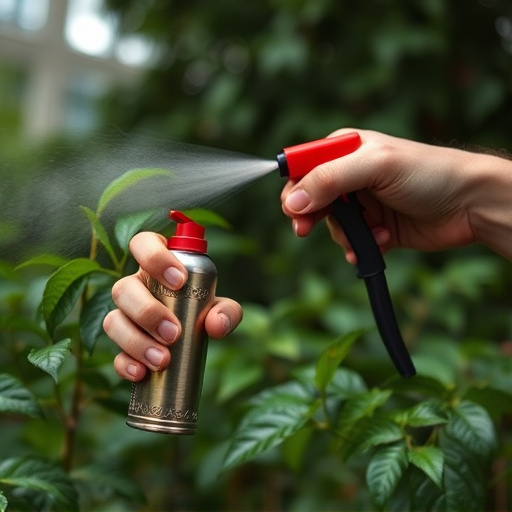Regularly check pepper spray expiration dates (2-5 years) to ensure potency. Inspect for discoloration, crystallization, or reduced pressure as indicators of spoilage. Understand local laws regarding pepper spray ownership and registration. Store in cool, dry places away from direct sunlight, extreme temps. Discard if past manufacturer's date for reliability.
“Staying prepared for unexpected situations is paramount, especially when it comes to self-defense. This comprehensive guide delves into the essential aspects of your pepper spray device, focusing on its expiration date checks. Learn about the active ingredients in pepper spray and their effectiveness lifespan, and master a step-by-step process to verify your spray’s potency.
We also debunk common expiry date myths, outline legal considerations for ownership, and provide expert storage tips to ensure your self-defense device remains a reliable tool when you need it most.”
- Understanding Pepper Spray's Active Ingredients and Their Lifespan
- How to Check If Your Spray is Still Effective: A Step-by-Step Guide
- Common Expiry Date Misconceptions and When to Replace Your Spray
- Legal Considerations: What You Need to Know About Pepper Spray Ownership
- Storage Tips to Maximize Your Self-Defense Device's Lifespan
Understanding Pepper Spray's Active Ingredients and Their Lifespan
Pepper spray, a popular self-defense device, is designed to temporarily incapacitate an assailant by causing discomfort and irritation. Understanding its active ingredients is crucial when it comes to effectiveness and safety. The primary component in most pepper sprays is capsaicin, a natural compound derived from chili peppers. This substance is responsible for the burning sensation and inflammation it causes upon contact with mucous membranes.
The lifespan of pepper spray is another important factor, especially considering its active ingredients’ potency over time. Pepper spray typically has an expiration date, ranging from 2 to 5 years, depending on the manufacturer’s recommendations. After this period, the capsaicin may degrade, reducing the spray’s impact and potentially leading to a less effective defense mechanism. Regularly checking the expiration date ensures that users have access to the highest quality and potent pepper spray when they need it most.
How to Check If Your Spray is Still Effective: A Step-by-Step Guide
To ensure your pepper spray device remains effective, it’s crucial to perform a regular expiration date check. Here’s a step-by-step guide on how to do this:
1. Locate the expiration date printed on the can. It’s typically found on the back or side of the spray container and is usually marked with a ‘use by’ or ‘expiry’ date.
2. Check if the date has passed. If the current date exceeds the expiration date listed, it’s time to replace your pepper spray. Note that once opened, most brands have a shorter shelf life, so check for any usage instructions on the packaging too.
Common Expiry Date Misconceptions and When to Replace Your Spray
Many people mistakenly believe that pepper spray, like other self-defense tools, has a standard expiry date similar to medications. However, this is not the case. Instead of a specific timeframe, the effectiveness of pepper spray depends on several factors, primarily the storage conditions and quality of the active ingredients.
Regularly checking your spray’s expiration date is essential, but more so, examining its condition will tell you when it needs replacing. After about 2-3 years, even if the label suggests a longer period, the spray’s potency can diminish due to chemical degradation. This means that if your pepper spray has exceeded this timeframe and shows signs of discoloration, crystallization, or reduced pressure, it should be replaced immediately. Always remember, when it comes to self-defense, staying prepared is crucial, so keep an eye on your equipment and dispose of old sprays responsibly.
Legal Considerations: What You Need to Know About Pepper Spray Ownership
Before considering a self-defense inflammatory spray device, understanding the legal landscape surrounding pepper spray ownership is paramount. Laws regarding pepper spray vary significantly from one jurisdiction to another, so what’s permitted in your region could differ vastly from neighboring areas. It’s crucial to check local laws and regulations for restrictions on pepper spray possession, including specific types allowed, age limitations, and registration requirements.
Additionally, keep in mind the pepper spray expiration date check. Unlike some over-the-counter products, self-defense sprays have limited shelf lives. Regularly inspect your device for any signs of wear or damage, and ensure it complies with current safety standards. Staying informed about these details empowers you to make a responsible decision regarding pepper spray ownership while adhering to the law.
Storage Tips to Maximize Your Self-Defense Device's Lifespan
To maximize the lifespan of your self-defense inflammatory spray device, proper storage is key. Keep it in a cool, dry place away from direct sunlight and extreme temperatures. Heat and moisture can degrade the effectiveness of pepper spray over time, so storing it in a climate-controlled environment ensures its optimal performance. Additionally, store it out of reach of children and pets to prevent accidental discharge.
Regularly check the expiration date of your pepper spray is crucial. Unlike food items, the shelf life of self-defense devices isn’t always apparent. Most manufacturers provide an expiration date or a best-before date on the packaging. Always discard the device if it’s past this date to ensure its potency and reliability in a critical situation. Remember, proper storage combined with regular maintenance can significantly extend the useful life of your self-defense inflammatory spray device.
Knowing how to properly check and maintain your pepper spray device, including understanding its expiration date, is a key component of effective self-defense. Regularly testing your spray’s potency ensures you’re prepared for any situation. By following the simple steps outlined in this guide—from ingredient awareness to legal knowledge—you can maximize the lifespan of your self-defense tool and feel confident in its reliability when needed most. Remember, staying informed is the first line of defense.
